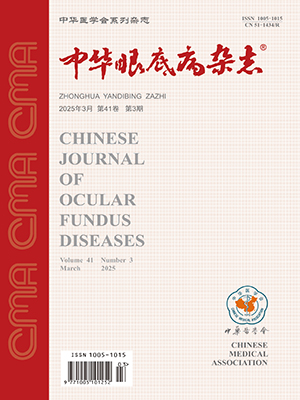| 1. |
Lo WR, Kim SJ, Aaberg TM Sr, et al. Visual outcomes and incidence of recurrent vitreous hemorrhage after vitrectomy in diabetic eyes pretreated with bevacizumab (avastin)[J]. Retina, 2009, 29(7): 926-931. DOI: 10.1097/IAE.0b013e3181a8eb88.
|
| 2. |
Ahmadieh H, Shoeibi N, Entezari M, et al. Intravitreal bevacizumab for prevention of early postvitrectomy hemorrhage in diabetic patients: a randomized clinical trial[J]. Ophthalmology, 2009, 116(10): 1943-1948. DOI: 10.1016/j.ophtha.2009.07.001.
|
| 3. |
Lee BJ, Yu HG. Vitreous hemorrhage after the 25-gauge transconjunctival sutureless vitrectomy for proliferative diabetic retinopathy[J]. Retina, 2010, 30(10): 1671-1677. DOI: 10.1097/IAE.0b013e3181dcfb79.
|
| 4. |
West JF, Gregor ZJ. Fibrovascular ingrowth and recurrent haemorrhage following diabetic vitrectomy[J]. Br J Ophthalmol, 2000, 84(8): 822-825.
|
| 5. |
Hershberger VS, Augsburger JJ, Hutchins RK, et al. Fibrovascular ingrowth at sclerotomy sites in vitrectomized diabetic eyes with recurrent vitreous hemorrhage: ultrasound biomicroscopy findings[J]. Ophthalmology, 2004, 111(6): 1215-1221. DOI: 10.1016/j.ophtha.2003.08.043.
|
| 6. |
Yeh PT, Yang CM, Yang CH, et al. Cryotherapy of the anterior retina and sclerotomy sites in diabetic vitrectomy to prevent recurrent vitreous hemorrhage: an ultrasound biomicroscopy study[J]. Ophthalmology, 2005, 112(12): 2095-2102. DOI: 10.1016/j.ophtha.2005.07.010.
|
| 7. |
Khuthaila MK, Hsu J, Chiang A, et al. Postoperative vitreous hemorrhage after diabetic 23-gauge pars plana vitrectomy[J]. Am J Ophthalmol, 2013, 155(4): 757-763. DOI: 10.1016/j.ajo.2012.11.004.
|
| 8. |
Wilkinson CP, Ferris FL, Klein RE, et al. Proposed international clinical diabetic retinopathy and diabetic macular edema disease severity scales[J]. Ophthalmology, 2003, 110(9): 1677-1682. DOI: 10.1016/S0161-6420(03)00475-5.
|
| 9. |
Soto-Pedre E, Hernaez-Ortega MC, Vazquez JA. Risk factors for postoperative hemorrhage after vitrectomy for diabetic retinopathy[J]. Ophthalmic Epidemiol, 2005, 12(5): 335-341. DOI: 10.1080/09286580500227068.
|
| 10. |
Sato T, Tsuboi K, Nakashima H, et al. Characteristics of cases with postoperative vitreous hemorrhage after 25-gauge vitrectomy for repair of proliferative diabetic retinopathy[J]. Graefe’s Arch Clin Exp Ophthalmol, 2017, 255(4): 665-671. DOI: 10.1007/s00417-016-3522-8.
|
| 11. |
Balakrishnan D, Jain B, Nayaka A, et al. Role of tamponade in vitrectomy for proliferative diabetic retinopathy with vitreous hemorrhage[J/OL]. Semin Ophthalmol, 2016, 2016: E1[2016-04-29].http://www.tandfonline.com/doi/full/10.3109/08820538.2015.1120757. DOI: 10.3109/08820538.2015.1120757. [published online ahead of print].
|
| 12. |
Ahn J, Woo SJ, Chung H, et al. The effect of adjunctive intravitreal bevacizumab for preventing postvitrectomy hemorrhage in proliferative diabetic retinopathy[J]. Ophthalmology, 2011, 118(11): 2218-2226. DOI: 10.1016/j.ophtha.2011.03.036.
|
| 13. |
Yan H, Cui J, Lu Y, et al. Reasons for and management of postvitrectomy vitreous hemorrhage in proliferative diabetic retinopathy[J]. Curr Eye Res, 2010, 35(4): 308-313. DOI: 10.3109/02713680903572491.
|
| 14. |
Bhende M, Agraharam SG, Gopal L, et al. Ultrasound biomicroscopy of sclerotomy sites after pars plana vitrectomy for diabetic vitreous hemorrhage[J]. Ophthalmology, 2000, 107(9): 1729-1736.
|
| 15. |
Shen X, Chen Y, Wang Y, et al. Intravitreal ranibizumab injection as an adjuvant in the treatment of neovascular glaucoma accompanied by vitreous hemorrhage after diabetic vitrectomy[J/OL]. J Ophthalmol, 2016, 2016: 4108490[2016-05-16]. https://dx.doi.org/10.1155/2016/4108490. DOI: 10.1155/2016/4108490.
|




